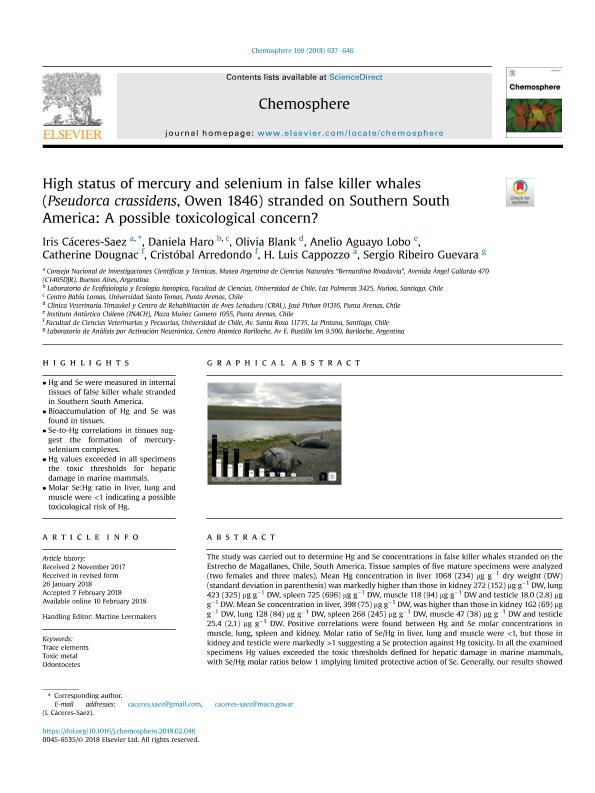Mostrar el registro sencillo del ítem
dc.contributor.author
Cáceres Saez, Iris

dc.contributor.author
Haro, Daniela
dc.contributor.author
Blank, Olivia
dc.contributor.author
Aguayo Lobo, Anelio
dc.contributor.author
Dougnac, Catherine
dc.contributor.author
Arredondo, Cristóbal
dc.contributor.author
Cappozzo, Humberto Luis

dc.contributor.author
Ribeiro, Sergio

dc.date.available
2020-01-14T14:38:11Z
dc.date.issued
2018-05
dc.identifier.citation
Cáceres Saez, Iris; Haro, Daniela; Blank, Olivia; Aguayo Lobo, Anelio; Dougnac, Catherine; et al.; High status of mercury and selenium in false killer whales (Pseudorca crassidens, Owen 1846) stranded on Southern South America: A possible toxicological concern?; Pergamon-Elsevier Science Ltd; Chemosphere; 199; 5-2018; 637-646
dc.identifier.issn
0045-6535
dc.identifier.uri
http://hdl.handle.net/11336/94595
dc.description.abstract
The study was carried out to determine Hg and Se concentrations in false killer whales stranded on the Estrecho de Magallanes, Chile, South America. Tissue samples of five mature specimens were analyzed (two females and three males). Mean Hg concentration in liver 1068 (234) μg g−1 dry weight (DW) (standard deviation in parenthesis) was markedly higher than those in kidney 272 (152) μg g−1 DW, lung 423 (325) μg g−1 DW, spleen 725 (696) μg g−1 DW, muscle 118 (94) μg g−1 DW and testicle 18.0 (2.8) μg g−1 DW. Mean Se concentration in liver, 398 (75) μg g−1 DW, was higher than those in kidney 162 (69) μg g−1 DW, lung 128 (84) μg g−1 DW, spleen 268 (245) μg g−1 DW, muscle 47 (38) μg g−1 DW and testicle 25.4 (2.1) μg g−1 DW. Positive correlations were found between Hg and Se molar concentrations in muscle, lung, spleen and kidney. Molar ratio of Se/Hg in liver, lung and muscle were <1, but those in kidney and testicle were markedly >1 suggesting a Se protection against Hg toxicity. In all the examined specimens Hg values exceeded the toxic thresholds defined for hepatic damage in marine mammals, with Se/Hg molar ratios below 1 implying limited protective action of Se. Generally, our results showed that individuals are carrying a significant burden, reflecting a high exposure to this toxic metal. This constitutes the first report on Hg and Se levels for a large subantarctic odontocete in South America region, providing insights into their contamination status and with information to the understanding of possible impacts on wild populations.
dc.format
application/pdf
dc.language.iso
eng
dc.publisher
Pergamon-Elsevier Science Ltd

dc.rights
info:eu-repo/semantics/openAccess
dc.rights.uri
https://creativecommons.org/licenses/by-nc-sa/2.5/ar/
dc.subject
ESTRECHO DE MAGALLANES
dc.subject
ODONTOCETES
dc.subject
SOUTHWESTERN SOUTH ATLANTIC OCEAN
dc.subject
STRANDINGS
dc.subject
TOXIC METAL
dc.subject
TRACE ELEMENTS
dc.subject.classification
Otros Tópicos Biológicos

dc.subject.classification
Ciencias Biológicas

dc.subject.classification
CIENCIAS NATURALES Y EXACTAS

dc.subject.classification
Otros Tópicos Biológicos

dc.subject.classification
Ciencias Biológicas

dc.subject.classification
CIENCIAS NATURALES Y EXACTAS

dc.title
High status of mercury and selenium in false killer whales (Pseudorca crassidens, Owen 1846) stranded on Southern South America: A possible toxicological concern?
dc.type
info:eu-repo/semantics/article
dc.type
info:ar-repo/semantics/artículo
dc.type
info:eu-repo/semantics/publishedVersion
dc.date.updated
2019-10-16T19:28:56Z
dc.journal.volume
199
dc.journal.pagination
637-646
dc.journal.pais
Países Bajos

dc.journal.ciudad
Amsterdam
dc.description.fil
Fil: Cáceres Saez, Iris. Consejo Nacional de Investigaciones Científicas y Técnicas. Oficina de Coordinación Administrativa Parque Centenario. Museo Argentino de Ciencias Naturales “Bernardino Rivadavia”; Argentina
dc.description.fil
Fil: Haro, Daniela. Universidad de Chile; Chile. Universidad Santo Tomas; Chile
dc.description.fil
Fil: Blank, Olivia. Clínica Veterinaria Timaukel; Chile. Centro de Rehabilitación de Aves Leñadura ; Chile
dc.description.fil
Fil: Aguayo Lobo, Anelio. Instituto Antártico Chileno; Chile
dc.description.fil
Fil: Dougnac, Catherine. Universidad de Chile; Chile
dc.description.fil
Fil: Arredondo, Cristóbal. Universidad de Chile; Chile
dc.description.fil
Fil: Cappozzo, Humberto Luis. Consejo Nacional de Investigaciones Científicas y Técnicas. Oficina de Coordinación Administrativa Parque Centenario. Museo Argentino de Ciencias Naturales “Bernardino Rivadavia”; Argentina
dc.description.fil
Fil: Ribeiro, Sergio. Comisión Nacional de Energía Atómica. Gerencia del Área de Energía Nuclear. Unidad de Actividad de Ingeniería Nuclear. Laboratorio de Análisis por Activación Neutrónica; Argentina
dc.journal.title
Chemosphere

dc.relation.alternativeid
info:eu-repo/semantics/altIdentifier/url/https://www.sciencedirect.com/science/article/pii/S0045653518302480
dc.relation.alternativeid
info:eu-repo/semantics/altIdentifier/doi/http://dx.doi.org/10.1016/j.chemosphere.2018.02.046
Archivos asociados
